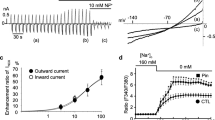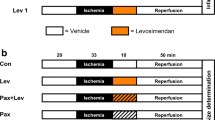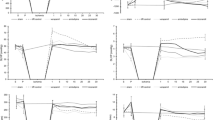Summary
Pinacidil is a member of the new antihypertensive drug family possessing an action that involves an increased, potassium efflux in vascular and cardiac muscle. We investigated the contribution of opening of ATP-sensitive potassium channel to the development of reperfusion-induced arrhythmias and myocardial ion shifts, particularly that of Na+, K+, Ca2+ and Mg2+ in isolated rat hearts. After 30 min of normothermic global ischemia, pinacidil with 1 to 60 μmol/l failed to reduce the incidence of reperfusion-induced arrhythmias, even on the postischemic/reperfused myocardium in a subset of hearts unresponsive to reperfusion-induced arrhythmias (the duration of ischemia was reduced to 25 min), pinacidil treatment was associated with a greater incidence of reperfusion-induced arrhythmias (100%) as compared to the control value (50%). These proarrhythmic effects of pinacidil were also reflected in a maldistribution of myocardial ion contents both in nonischemic and ischemic/reperfused hearts. Cicletanine, a furopyridine antihypertensive agent that has no effect on coronary resistance, reduced the incidence of reperfusion arrhythmias, and its antiarrhythmic effect was antagonized by pinacidil. The same observation was made in relation to myocardial ion content, e.g., pinacidil-induced K+ loss and Ca2+ gain were antagonized by cicletanine, both in nonischemic and ischemic/reperfused hearts. It is hypothesized that the increased tendency to develop reperfusion-induced ventricular fibrillation is associated with the pinacidil-induced K+ efflux. The present study does not attempt to address the question of specific ionic currents; however, it has been suggested that proarrhythmic and antiarrhythmic effects of pinacidil and cicletanine, respectively, may relate to same receptor sites in which the latter may reflect a specific blockade of the outward K+ ion current via ATP-sensitive K+ channels. If this is so, the use of K+ channel openers as antihypertensive agents may be of particular concern in that population of postinfarction patients who are known to be at high risk of sudden coronary death.
Similar content being viewed by others
References
Ahnfelt-Ronne I (1988) Pinacidil: history, basic pharmacology, and therapeutic implications. J Cardiovasc Pharmacol 12, (Suppl 2): S1-S4
Alto LE, Dhalla NS (1979) Myocardial cation contents during induction of calcium paradox. Am J Physiol 237:713–719
Bache RJ, Dai XZ, Baran K (1990) Effect of pinacidil on myocardial blood flow in the chronically pressure overloaded hypertrophied left ventricle. J Cardiovasc Pharmac 16:890–895
Baum RS, Alvarez H, Cobb LA (1974) Survival after resuscitation from out-of-hospital ventricular fibrillation. Circulation 50:1231–1235
Bekheit SS, Restivo M, Boutjdir M, Henkin R, Gooyandeh K, Assadi M, Khatib S, Gough WB, El-Sherif N (1990) Effects of glyburide on ischemia-induced changes in extracellular potassium and local myocardial activation: a new approach to the management of ischemia-induced malignant ventricular arrhythmias. Am. Heart J 119:1025–1033
Bray KM, Newgreen DT, Small RC, Southerton JS, Taylor SG, Weir SW, Weston AH (1987) Evidence that the mechanism of the inhibitory action of pinacidil in rat any guinea-pig smooth muscle differs from that of glyceryl trinitrate. Br J Pharmacol 91:421–429
Cavero I, Mondot M, Mestre M, Escande D (1988) Haemodynamic and pharmacological mechanisms of the hypotensive effects of cromakalim in rats: blockade by glibenclamide. Br J Pharmacol 95:P643
Cercek B, Horvat M (1985) Arrhythmias with brief, high-dose intravenous streptokinase infusion in acute myocardial infarction. Eur Heart J 6:109–113
Chabrier PE, Guinot P, Tarrade T, Auguet M, Cabanie M, Clostre F, Etienne A Esanu A, Braquet P (1988) Cicletanine. In: Scriabine A (ed) Cardiovascular Drug Reviews. Raven Press, New York, pp. 166–179
Cole WC, McPherson CD, Sontag D (1991) ATP-regulated K+ channels protect the myocardium against ischemia/reperfusion damage. Circ Res 69:571–581
Coronel R, Fiolet JWT, Wilms-Schopman FJG, Schaapherder AFM, Johnson TA, Gettes LS, Janse MJ (1988) Distribution of extracellular potassium and its relation to electrophysiologic changes during acute myocardial ischemia in the isolated perfused porcine heart. Circulation 77:1125–1138
Corr PB, Cain ME, Witkowski FX, Price DA, Sobel BA (1979) Potential arrhythmogenic derangements in canine Purkinje fibers induced by lysophosphoglycerides. Circ Res 44:822–832
Corr PB, Creer MH, Yamada KA, Saffitz JE, Sobel BE (1989) Prophylaxis of early ventricular fibrillation by inhibition of acylcarnitine, accumulation. J Clin Invest 83:927–936
Dennis SC, Coetzee WA, Cragoe EJ, Opie LH (1990) Effects of proton buffering and of amiloride derivatives on reperfusion arrhythmias in isolated rat hearts. Circ Res 66:1156–1159
Elharrar V, Zipes DP (1977) Cardiac electrophysiologic alterations during myocardial ischemia. Am J Physiol 233:H329-H345
Elz JS, Nayler WG (1988) Contractile activity and reperfusion-induced calcium gain after ischemia in the isolated rat heart. Lab Invest 58:653–659
Fish FA, Prakash C, Roden DM (1990) Suppression of repolarization-related arrhythmias in vitro and in vivo by low-dose potassium channel activators. Circulation 82:1362–1369
Fosset M, De Weille JR, Green RD, Schmid-Antomarchi H, Lazdunski M (1988) Antidiabetic sulfonylureas control action, potential properties in heart cells via high affinity receptors that are linked to ATP-dependent K+ channels. J Biol Chem 263:7933–7936
Furberg CD (1983) Effects of antiarrhythmic drugs on mortality after myocardial infarction. Am J Cardiol 52:632–636
Garay RP, Nazaret C, Diez J, Etienne A, Bouragin R, Braquet P (1984) Stimulation of K+ fluxes by diuretic drugs in human red cells. Biochem Pharmacol 33:2013–2020
Gettes LS, Surawicz B, Kim KH (1966) Role of myocardial K+ and Ca2+ in initiation and inhibition of ventricular fibrillation. Am J Physiol 211:699–702
Goldberg S, Greenspan AJ, Urban PL, Muza B, Berger B, Walinsky P, Maroko PR (1983) Reperfusion arrhythmia: a marker of restoration of antegrade flow during intracoronary thrombolysis for acute myocardial infarction. Am J Cardiol 105:26–32
Golberg MR, Sushak CS, Rockhold FW, Thompson WL (1988) Vasodilator monotherapy in the treatment of hypertension: comparative efficacy and safety of, pinacidil, a potassium channel opener, and prazosin. Clin Pharmacol Ther 44:78–92
Grover GJ, Dzwonczyk S, Parham CS, Sleph PG (1990) The protective effects of cromakalim and pinacidil on reperfusion function and infarct size in isolated perfused rat hearts and anesthetized dogs. Cardiovasc Drugs Ther 4:465–474
Grover GJ, McCullough JR, Henry DE, Conder ML, Sleph PG (1990) Anti-ischemic effects of the potassium activators pinacidil and cromakalim and the reversal of these effects with the potassium channel blocker glyburide. J Pharmacol Exp Ther 251:98–104
Hamilton TC, Weston AH (1989) Minireview: Cromakalim, nicorandil and pinacidil: novel drugs which open potassium channel in smooth muscle. Gen Pharmacol 20:1–6
Hearse DJ (1990) Ischemia, reperfusion, and the determinants of tissue injury. Cardiovasc Drug Ther 4:767–776
Jelicks LA, Gupta RK (1989) Multinuclear NMR studies of the Langendorff perfused rat heart. J Biol Chem 264:15230–15235
Jouve R, Langlet F, Puddu PE, Rolland PH, Guillen JC, Cano JP, Serradimigni A (1986) Cicletanine improves outcome after left circumflex coronary artery, occlusion-reperfusion in the dog. J Cardiovasc Pharmacol 8:208–215
Jouve R, Puddu PE, Langlet F, Lanti M, Guillen JC, Rolland PH, Serradimigni A (1988) Effect of cicletanine in the left circumlfex coronary artery, occlusion-reperfusion canine model of sudden death: analysis of 107 experiments using Cox's propositional hazards model Drugs Exp Clin Res 14:167–179
Kaplinsky E, Ogawa S, Michelson EL, Dreifus LS (1981) Instantaneous and delayed ventricular arrhythmias after, reperfusion of acutely ischemic myocardium: evidence for multiple mechanisms Circulation 63:333–340
Katz AM, Reuter H (1979) Cellular calcium and cell death. Am J Cardiol 44:188–190
Kirkels JH, van Echteld CJA, Ruigrok TJC (1989) Intracellular magnesium during myocardial ischemia and reperfusion: possible consequences for postischemic recovery. J Mol Cell Cardiol 21:1209–1218
Lazdunski M, Frelin C, Vigne P (1985) The sodium/hydrogen exchange system in cardiac cells: its biochemical and pharmacological properties and its role in regulating internal concentrations of sodium and internal pH. J Mol Cell Cardiol 17:1029–1042
Lucchesi BR, Werns SW, Fantone JC (1989) The role of the neutrophil and free radicals in ischemic myocardial injury. J Mol Cell Cardiol 21:1241–1251
May GS, Furberg CD, Eberlein KA, Geraci BJ (1983) Secondary prevention after myocardial infarction: a review of short-term acute phase trials. Prog Cardiovasc Dis 25:335–359
Meisheri KD, Swirtz MA, Purhoit SS, Cipkus-Dubray LA, Khan SA, Oleynek JJ (1991) Characterization of K+ channel-dependent as well as-independent components of pinacidil-induced vasodilation. J Pharmacol Exp Ther 256:492–499
Meng H, Pierce GN (1991) Involvement of sodium in the protective effect of 5-(N,N-dimethyl)-amiloride on ischemia-reperfusion injury in isolated rat ventricular wall. J Pharmacol Exp Ther 256:1094–1100
McCullough JR, Normandin DE, Conder ML, Sleph PG, Dzwonczyk S, Grover GJ (1991) Specific block of the anti-ischemic actions of cromakalim by sodium 5-hydroxydecanoate. Circ Res 69:949–958
McPherson GA, Angus JA (1990) Characterization of responses to cromakalim and pinacidil in smooth and cardiac muscle by use of selective antagonists. Br J Pharmacol 100:201–206
Montrucchio G, Alloatti G, Mariano F, de Paulis R, Comino A, Emanuelli G, Camussi G (1990) Role of platelet activating factor in the reperfusion injury of rabbit ischemit heart. Am J Pathol 137:71–83
Murohara Y, Yui Y, Hattori R, Kawai C (1991) Effects of superoxide dismutase on reperfusion arrhythmias and left ventricular function in patients undergoing thrombolysis for anterior wall acute myocardial infarction. Am J Cardiol 67:765–767
Nayler WG, Elz JD, Buckley DJ (1988) Dissociation of hypoxia-induced calcium gain and rise in resting tension in isolated rat hearts. Am J Physiol 254:H678-H685
Opie LH, Thandroyen FT (1984) Molecular and biochemical mechanisms underlying the role of calcium ions in malignant ventricular arrhythmias. Ann NY Acad Sci 427:127–139
Parratt JR, Coker SJ, Wainwright CL (1987) Eicosanoids and suseceptibility to ventricular arrhythmias during myocardial ischemia and reperfusion. J Moll Cell Cardiol 19 (Suppl 5):55–66
Podzuweit T, Dalby AJ, Cherry GW, Opie LH (1978) Cyclic AMP levels in ischemic and nonischemic myocardium following coronary artery ligation: relation to ventricular fibrillation. J Moll Cell Cardiol 10:81–94
Poole-Wilson PA, Harding DP, Bourdillon PDV, Tones MA (1984) Calcium out of control. J Mol Cell Cardiol 16:175–187
Pridjian AK, Levitsky S, Krukenkamp I, Silverman NA, Feinberg H (1987) Developmental changes in reperfusion injury: a comparison of intracellular cation accumulation in the newborn, neonatal, and adult heart. J Thorac Cardiovasc Surg 93:428–433
Romani A, Scarpa A (1990) Hormonal control of Mg2+ transport in the heart. Nature 346:841–844
Shattock MJ, Hearse DJ, Fry CH (1987) The ionic basis of the anti-ischemic and anti-arrhythmic properties of magnesium in the heart. J Am Coll Nutr 6:27–33
Sheridan DJ, Penkoske PA, Sobel BE, Corr PB (1980) Alpha adrenergic contributions to dysrhythmia during myocardial ischemia and reperfusion in cats. J Clin Invest 65:161–171
Simoons ML, Serruys PW, Van den Brand M, Res J, Verheught FWA, Krauss XH, Remme WJ, Bar F, De Zwaan C, Van der Laarse A, Vermeer F, Lubsen J (1986) Early thrombolysis in acute myocardial infarction: limitation of infarct size and improved survival. J Am Coll Cardiol 7:717–728
Smallwood JK, Steinberg MI (1988) Cardiac electrophysiological effects of pinacidil and related pyridilcyanoguanidines: relationship to antihypertensive activity. J Cardiovasc Pharmacol 12:102–109
Spinelli W, Follmer C, Parsons R, Colatsky T (1990) Effects of cromakalim, pinacidil and nicorandil on cardiac refractoriness and arterial pressure in open-chest dogs. Eur J Pharmac 179:243–252
Spinelli W, Sorota S, Siegal M, Hoffman BF (1991) Antiarrhythmic actions of the ATP-regulated K+ current activated by pinacidil. Circ Res 68:1127–1137
Tani M, Neely JR (1989) Role of intracellular Na+ in Ca2+ overload and depressed recovery of ventricular function of reperfused ischemic rat hearts: possible involvement of H+−Na+ and Na+−Ca2+ exchange. Circ Res 65:1045–1056
Tosaki A, Koltai M, Braquet P (1989) Effects of low extracellular sodium concentration on reperfusion induced arrhythmias: changes in the myocardial sodium, potassium and calcium contents in isolated guinea pig hearts. Cardiovasc Res 23:993–1000
Tosaki A, Blasig IE, Pali T, Ebert B (1990) Heat protection and radical trapping by DMPO during reperfusion in isolated working rat hearts. Free Rad Biol Med 8:363–372
Tosaki A, Koltai M, Paubert-Braquet M (1990) Effect of iloprost on reperfusion-induced arrhythmias and myocardial ion shifts in isolated rat hearts. Eur J Pharmacol 191:69–81
Tosaki A, Braquet P (1990) DMPO and reperfusion injury: arrhythmia, heart function, electron spin resonance, and nuclear magnetic resonance studies in isolated working guinea pig hearts. Am Heart J 120:819–830
Tosaki A, Hellegouarch A, Braquet P (1991) Cicletanine and reperfusion injury: is there any correlation between arrhythmias, 6-keto-PGF1, thromboxane B2, and myocardial ion shifts (Na+, K+, Ca2+, and Mg2+) induced by ischemia/reperfusion in isolated rat heart. J Cardiovasc Pharmacol 17:551–559
Tosaki A, Viossat I, Braquet P (1991) Effect of cicletanine on reperfusion-induced arrhythmias and its relation to 6-keto-PGF1 and TXB2 release. J Can Phys Pharmacol 69:488–493
Tzivoni D, Keren A (1990) Suppression of ventricular arrhythmias by magnesium. Am J Cardiol 65:1397–1399
Vatner SF, Patrick TA, Knight DR, Manders WT, Fallon JT (1988) Effects of calcium channel blocker on responses of blood flow, function, arrhythmias, and extent of infarction following reperfusion in conscious baboons. Circ Res 62:105–115
Walker MJA, Curtis MJ, Hearse DJ, Campbell RWF, Janse MJ, Yellon DM, Cobbe SM, Coker SJ, Harness JB, Harron DWG, Higgins AJ, Julian DJ, Lab MJ, Manning AS, Northover BJ, Parratt JR, Riemersma RA, Riva E, Russel DC, Sheridan DJ, Winslow E, Woodward B (1988) The Lambeth conventions: guidelines for the study of arrhythmias in ischemia, infarction and reperfusion. Cardiovasc Res 22:447–455
Walsh LG, Tormey J McD (1988) Subcellular electrolyte shifts during in vitro myocardial ischemia and reperfusion. Am J Physiol 255:H917-H928
Weis MT, Malik KU (1989) The influence of mono-and divalent cations on the cardiac metabolism of arachidonic acid. Prostaglandins 37:707–723
Wilde AAM, Escande D, Schumacher CA, Thuringer D, Mestre M, Fiolet JWT, Janse MJ (1990) Potassium accumulation in the globally ischemic mammalian heart: a role for the ATP-sensitive potassium channel. Circ Res 67:835–843
Winquist RJ, Heaney LA, Wallace AA, Baskin EP, Stein RB, Gracia ML, Kaczorowsky GJ (1989) Glyburide blocks the relaxation response to BRL 34915 (cromakalim), minoxidil sulfate and diazoxide in vascular smooth muscle. J Pharmacol Exp Ther 248:149–156
Wolleben CD, Sanguinetti MC Siegl PKS (1989) Influence of ATP-sensitive potassium channel modulators on ischemia-induced fibrillation in isolated rat hearts. J Mol Cell Cardiol 21:783–788
Author information
Authors and Affiliations
Rights and permissions
About this article
Cite this article
Tosaki, A., Szerdahelyi, P. & Das, D.K. Reperfusion-induced arrhythmias and myocardial ion shifts: A pharmacologic interaction between pinacidil and cicletanine in isolated rat hearts. Basic Res Cardiol 87, 366–384 (1992). https://doi.org/10.1007/BF00796522
Received:
Accepted:
Issue Date:
DOI: https://doi.org/10.1007/BF00796522




